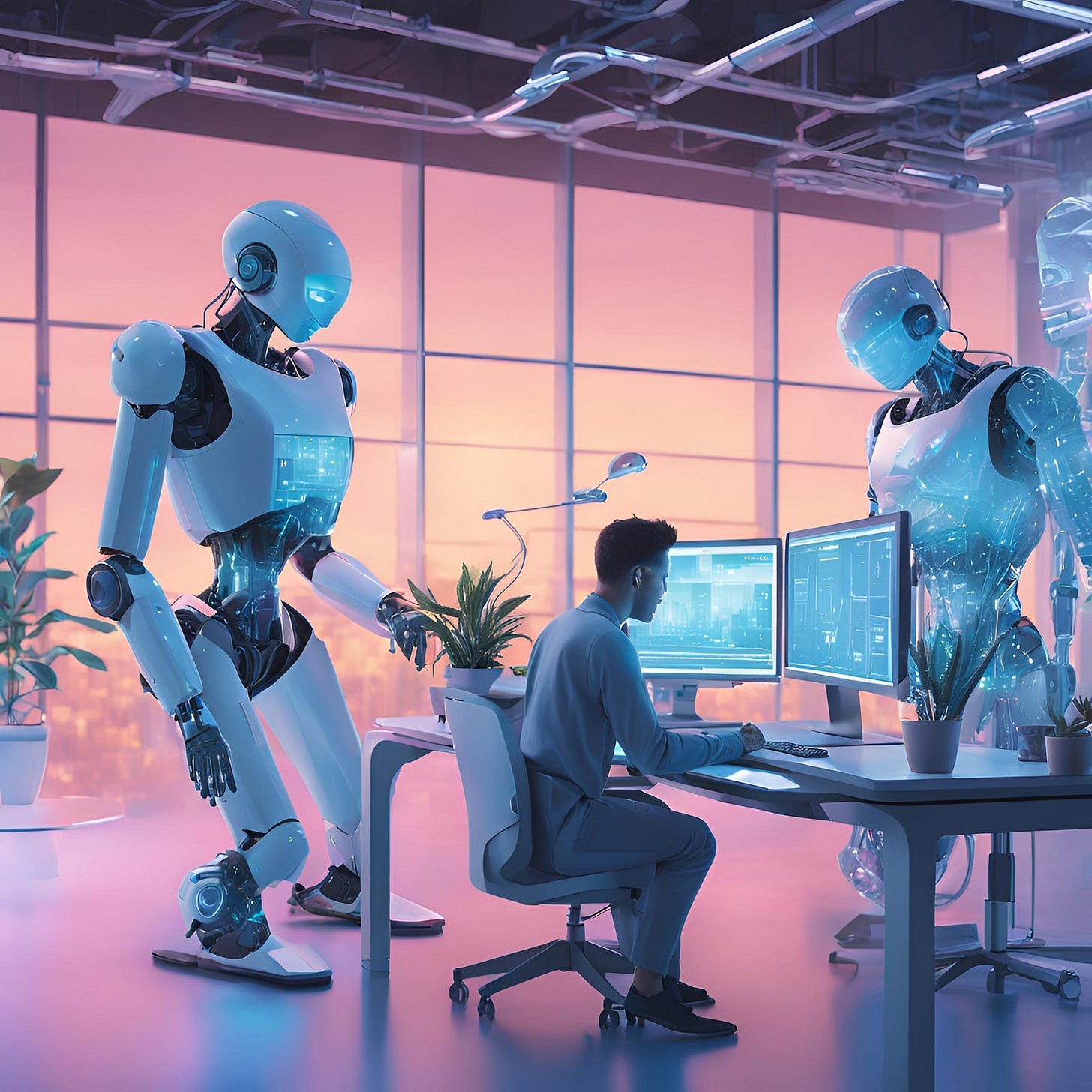AI Simplified: Understanding Its Power and Potential
Exploring AI’s Role in Our World Today and Tomorrow
Hey, this is Darshana ! After a lot of thought, I’ve decided to dive into my AI journey seriously. From casually reading articles to feeling completely lost in all the jargon, I realized it’s time to start from scratch. I’ll be documenting my research here and promise to keep it simple — because I know firsthand how overwhelming it can feel!
I’m taking a leap into the AI world, and I want you to grow with me as we uncover its potential and opportunities.
Feel free to share your thoughts or suggest topics you’d like me to explore or research.
You might be thinking, “Why should I learn about AI? I’m not an AI engineer!” Well, neither am I. Maybe it’s just FOMO — AI is everywhere, and you can’t escape the buzz. But here’s the thing: even if you’re not an AI scientist or an engineer, we’re heading towards a world where AI will be a part of everything we do. Knowing the basics won’t hurt; in fact, it might help you better understand what you’re interacting with.
From the little research I’ve done so far, I can tell you this: the way I communicate with and use AI tools like ChatGPT and Bard has drastically improved. It made me realize how much more I could uncover with a deeper understanding of what’s happening in the AI world.
What is AI?
Imagine you’re driving to a friend’s house, but you’re not sure which route to take. You open Google Maps, type in the address, and it gives you:
The fastest route.
Alternate routes.
Updates about traffic jams or accidents.
So whats happening here? AI is at work behind the scenes!
Google Maps uses AI to analyze data from the phones of other drivers on the road, like how fast their phones are moving, to figure out:
Where traffic is heavy.
How long a route will take.
If there’s a quicker way based on real-time conditions.
AI, or Artificial Intelligence, is when machines or software try to act a bit like humans — thinking, learning, and solving problems. It’s like training your devices to be more intuitive, allowing them to make smart choices and improve over time, rather than just doing what they’re told.
You can better understand AI by relating it to some of the devices or softwares or apps that you use every day that rely on AI in the background. Let’s explore some examples to see how AI is already a part of your daily life.
Ever noticed how Spotify or YouTube always seems to know what song you’ll love next? That’s AI! It learns your music taste based on what you listen to and suggests songs that match your vibe.
When you ask Siri, Alexa, or Google, “What’s the weather today?” and they give you the answer, that’s AI in action.
Ever added a pair of shoes to your cart and suddenly you see a suggestion, “People also bought these socks”? That’s AI noticing patterns and nudging you toward more shopping.
Your email app automatically moves spam to a separate folder. AI analyzes patterns in those emails (weird subject lines, unknown senders) and decides, “This doesn’t look right.”
In a nutshell, AI is like having a team of invisible helpers or assistants that do all this processing for you and save you the trouble so you can focus on more important things.
Now this isn’t just some kind of magic 🪄 — it’s just machines learning patterns and making smart guesses to make your life easier! More on this later.
Now that we have a basic, high-level understanding of AI, let’s dive a little deeper and explore how AI is broadly classified.
ANI, AGI & ASI
AI is broadly classified into:
Artificial Narrow Intelligence (ANI) or Weak AI
Artificial General Intelligence (AGI) or Strong AI
Artificial Super Intelligence (ASI)
Let’s take a closer look at what each of these mean. Don’t worry, I promise to keep it simple and breezy — no AI jargon overload here!
Artificial Narrow Intelligence (ANI)
An ANI model can do only one task at a time. For an AI to be classified as ANI, it should be able to perform only one specific task and cannot do anything outside the specified task. What this means is that, it is designed to do a single or a narrow range of tasks, like recommending movies, translating languages, or recognizing faces in photos.
It learns patterns from data or works based on explicit programming but cannot “think” or adapt outside its programming.
If you’re wondering what explicit programming is, it basically means, the model will be programmed with a set of instructions for different scenarios and it just follows these instructions.
For example:
If the traffic light is red, stop the car.
If the temperature is below 20°C, turn on the heater.
In this approach, the machine doesn’t learn or guess — it simply does what it’s told.
ANI doesn’t understand the context like humans do. For example, a chess AI is brilliant at chess but clueless about playing checkers, hence the name “narrow”.
ANI, or Artificial Narrow Intelligence, is a type of AI focused on solving a single task or a narrow range of problems using pre-programmed rules or data-driven learning. It doesn’t have the ability to think, adapt, or generalize beyond its specific function.
Listed below are some examples of ANI that we commonly use in our day to day life:
Voice Assistants: Siri or Alexa can answer questions, set alarms, or play music but can’t understand the broader context of a conversation.
Spam Filters: Email systems use ANI to detect and filter out spam messages based on patterns.
Navigation Apps: Google Maps helps you find the best route but won’t help you write a book.
Facial Recognition: Unlocking your phone with Face ID or tagging friends in photos on social media.
Recommendation Systems: Platforms like Amazon suggest products based on your browsing history.
Apart from the points mentioned above, it might surprise you to know that the well-known chat AI models, which took the world by storm with their advanced capabilities, also fall under the category of Artificial Narrow Intelligence (ANI). Surprising, right? I thought so too.
While AI models like ChatGPT and Bard can perform a wide range of tasks, their specialization remains focused on text and language. Just because they excel at text generation doesn’t mean they possess other forms of intelligence. And this is why they are classified under ANI.
Now, you might be wondering — what exactly is AGI? Don’t worry, I’ve got you covered. Keep reading to find out more!
Artificial General Intelligence (AGI)
AGI has been a dream which we haven’t achieved yet. Although, some believe that we are slowly inching towards it.
To qualify as AGI, a system must go beyond being good at one thing — it needs to be good at everything.
AGI would be capable of performing any intellectual task a human can, adapting to new tasks and solving problems it hasn’t been specifically trained for.
It would be able to tackle problems without the need of being reprogrammed.
It would be able to learn concepts on its own. Unlike ANI, which depends on pre-set data that is fed into it, AGI would be able to learn and provide solutions on its own.
AGI would be able to understand complex ideas, work with abstract data, and make decisions based on a broader understanding of things. In a nutshell, it would be capable of thinking and learning like a human.
AGI isn’t just about programming more rules or training on more data — it’s about creating a machine that genuinely “understands” like humans. This means replicating things like:
Common sense reasoning.
Emotional intelligence.
Creativity and abstract thinking.
If you had to imagine a true AGI model, consider a robot that can fix itself when it malfunctions, write software, paint a masterpiece, and debate philosophy — all without being explicitly programmed for these tasks.
As of now, AGI doesn’t exist. Researchers and futurists speculate it might be decades away — or longer.
Artificial Super Intelligence (ASI)
ASI is the kind of futuristic AI we see in movies. Artificial Super intelligence (ASI) is the hypothetical next step after AGI. It refers to a machine that doesn’t just match human intelligence — it far exceeds it in every way. Imagine an entity that’s smarter than the smartest human, more creative than any artist, and faster than any computer we currently have.
ASI would be able to outperform humans in every field, from scientific discoveries to artistic creation, ASI would do it all, better and faster than humans.
ASI would grasp and solve complex global challenges like poverty, climate change, and disease at a level beyond human ability.
The “Machines” from The Matrix or Skynet from the Terminator series are cautionary depictions of ASI.
ASI raises both hope and fear. While it could solve the world’s toughest problems, it could also surpass human control, potentially becoming a threat if not aligned with human values. These debates make ASI a topic of intense discussion in AI ethics and safety.
However, it isn’t something to worry about at the moment, as ASI is purely hypothetical.
Takeaway
AI is already a big part of our daily lives, helping us with tasks like navigation, recommendations, and voice assistants. While ANI focuses on doing specific tasks well, AGI aims to think and learn like humans, and ASI is a futuristic idea of super-smart machines.
If you found this article valuable and want to join in this journey with me, please subscribe to my Substack channel.
Feel free to share this article with anyone you think would benefit from it. Your support means the world to me, and I look forward to bringing you more insightful content .






